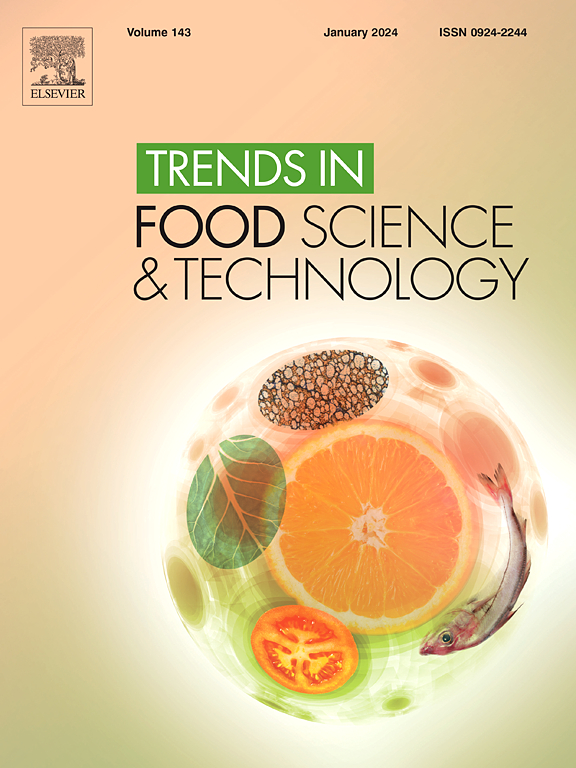Plant-mediated synthesis of zinc oxide nanoparticles and their applications in biopolymer-based sustainable food packaging: A state of-art-review
IF 15.1
1区 农林科学
Q1 FOOD SCIENCE & TECHNOLOGY
引用次数: 0
Abstract
Background
The physical and chemical synthesis methods of zinc oxide nanoparticles (ZnONPs) often require high energy or involve toxic reagents producing hazardous byproducts. Plant-mediated synthesis of ZnONPs, in retrospect, is a sustainable synthetic approach with significant potential for novel applications. Bioactive compounds of plant extracts act as reducing and stabilizing agents, offering an eco-friendly alternative to the conventional chemical and physical synthesis techniques. Plant-mediated ZnONPs exhibit comparable functional properties, including potential antimicrobial properties, exceptional UV-light barrier capabilities, and controlled release kinetics, making them ideal for enhancing the performance of biopolymer-based food packaging films.
Scope and approach
This review highlights synthesis of plant-mediated ZnONPs for application in biopolymeric packaging materials i.e., films and coatings, and their effects on the mechanical, thermal, antimicrobial, and other functional properties of the biopolymer matrix. Moreover, applications of ZnONPs incorporated biopolymer-based active films and coatings in packaging and shelf-life extension of perishable foods like fruits and vegetables, muscle foods, dairy products, etc. are also elaborated.
Key findings and conclusions
Biopolymer-based nanocomposite films have demonstrated efficacy in preserving the freshness and quality of perishable food products including fresh fruits, vegetables, muscle foods, and dairy items by inhibiting microbial growth and extending shelf-life. Additionally, their ability to serve as high-tensile, biodegradable packaging materials aligns with the global push toward reduction of synthetic plastics usage. The integration of plant-mediated ZnONPs offers a sustainable solution for food packaging and preservation challenges while minimizing environmental impact.
植物介导的氧化锌纳米颗粒合成及其在生物聚合物基可持续食品包装中的应用:最新进展
氧化锌纳米颗粒(ZnONPs)的物理和化学合成方法通常需要高能量或涉及有毒试剂产生有害副产物。回顾过去,植物介导的ZnONPs合成是一种可持续的合成方法,具有重要的新应用潜力。植物提取物的生物活性化合物作为还原和稳定剂,为传统的化学和物理合成技术提供了一种环保的选择。植物介导的ZnONPs具有类似的功能特性,包括潜在的抗菌特性、卓越的紫外线阻隔能力和控制释放动力学,使其成为提高生物聚合物基食品包装膜性能的理想选择。本文综述了植物介导的ZnONPs在生物聚合物包装材料(薄膜和涂层)中的应用,以及它们对生物聚合物基质的机械、热、抗菌和其他功能特性的影响。此外,还阐述了含ZnONPs生物聚合物活性薄膜和涂层在水果和蔬菜、肌肉食品、乳制品等易腐食品的包装和延长保质期方面的应用。主要发现和结论生物聚合物基纳米复合薄膜通过抑制微生物生长和延长货架期,在保持易腐食品(包括新鲜水果、蔬菜、肌肉食品和乳制品)的新鲜度和质量方面已被证明有效。此外,它们作为高强度、可生物降解包装材料的能力与全球减少合成塑料使用的趋势相一致。植物介导的ZnONPs的整合为食品包装和保存挑战提供了可持续的解决方案,同时最大限度地减少对环境的影响。
本文章由计算机程序翻译,如有差异,请以英文原文为准。
求助全文
约1分钟内获得全文
求助全文
来源期刊

Trends in Food Science & Technology
工程技术-食品科技
CiteScore
32.50
自引率
2.60%
发文量
322
审稿时长
37 days
期刊介绍:
Trends in Food Science & Technology is a prestigious international journal that specializes in peer-reviewed articles covering the latest advancements in technology, food science, and human nutrition. It serves as a bridge between specialized primary journals and general trade magazines, providing readable and scientifically rigorous reviews and commentaries on current research developments and their potential applications in the food industry.
Unlike traditional journals, Trends in Food Science & Technology does not publish original research papers. Instead, it focuses on critical and comprehensive reviews to offer valuable insights for professionals in the field. By bringing together cutting-edge research and industry applications, this journal plays a vital role in disseminating knowledge and facilitating advancements in the food science and technology sector.
 求助内容:
求助内容: 应助结果提醒方式:
应助结果提醒方式:


